I couldn’t bring you last month’s Roundup because my parcel
of review books from Osprey went astray somewhere in the post, but I now
have replacements (thanks, Osprey!) so here’s a double helping in
no particular order of publication.
Battle Orders 18, British Commandos 1940-46, by Tim Moreman, ISBN 1-84176-986-X,
96 pages
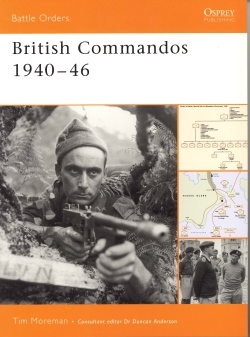 This
is a fascinating book for anyone interested in Special Forces, dealing
as it does with the first of the WW2 raiding formations. The first 40
pages deal in detail with organisation and training as they changed through
the war, not just the British Army Commandos but the Royal Marine and
allied nation Commando units as well. The next 10 pages deal with command
arrangements and weapons, and are followed by in-depth analyses of 6 different
operations – the fiasco on Guernsey in July 1940, the Lofoten and
Vaagso raids, St Nazaire, the assault on Walcheren, and 3rd Commando Brigade’s
battle for Hill 170 in the Arakan campaign, with good maps to show the
courses of the actions. Although this is not a “uniform book”
there are plenty of good photographs showing how the Commandos were dressed
and equipped, and the Walcheren account in particular will be useful for
any modeller wanting to put Commando figure with an Italeri LVT. This
is a fascinating book for anyone interested in Special Forces, dealing
as it does with the first of the WW2 raiding formations. The first 40
pages deal in detail with organisation and training as they changed through
the war, not just the British Army Commandos but the Royal Marine and
allied nation Commando units as well. The next 10 pages deal with command
arrangements and weapons, and are followed by in-depth analyses of 6 different
operations – the fiasco on Guernsey in July 1940, the Lofoten and
Vaagso raids, St Nazaire, the assault on Walcheren, and 3rd Commando Brigade’s
battle for Hill 170 in the Arakan campaign, with good maps to show the
courses of the actions. Although this is not a “uniform book”
there are plenty of good photographs showing how the Commandos were dressed
and equipped, and the Walcheren account in particular will be useful for
any modeller wanting to put Commando figure with an Italeri LVT.
Highly recommended
Campaign 162, Inch’on 1950, The last great amphibious assault,
by Gordon L Rottman, illustrated by Peter Dennis, ISBN 1-8476-961-4, 96
pages
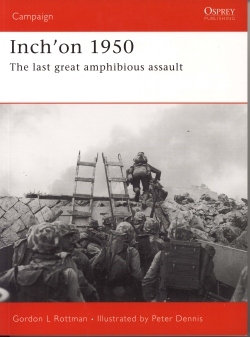 The
Korean War opened with a surprise attack by North Korea across the 38th
Parallel, the border between the two Koreas. Seoul, South Korea’s
capital, was only a few miles south of the border and fell in three days.
South Korean forces were heavily outnumbered and poorly equipped so were
driven steadily south. The UN authorised action, and US and Commonwealth
forces were rapidly committed by unfortunately the US Army and Marines
had suffered badly from “peace dividend” thinking and were
very low in combat strength. The nearest US units, in Japan, had only
light tanks and almost no recent training but were rushed to Korea only
to be swept away and forced back to a perimeter at Pusan in the southwest. The
Korean War opened with a surprise attack by North Korea across the 38th
Parallel, the border between the two Koreas. Seoul, South Korea’s
capital, was only a few miles south of the border and fell in three days.
South Korean forces were heavily outnumbered and poorly equipped so were
driven steadily south. The UN authorised action, and US and Commonwealth
forces were rapidly committed by unfortunately the US Army and Marines
had suffered badly from “peace dividend” thinking and were
very low in combat strength. The nearest US units, in Japan, had only
light tanks and almost no recent training but were rushed to Korea only
to be swept away and forced back to a perimeter at Pusan in the southwest.
McArthur, having commanded US forces in much of the Pacific during World
War 2, was still in Japan as commander of the South East Asia area and
was of course in command of the efforts to save South Korea. Unfortunately
some of his subordinate commanders were not exactly up to speed in combat
command, and some really stupid operations were considered. McArthur was
aware that a Pentagon contingency plan had been completed only a few weeks
before the North Korean attack, envisaging a counterattack against just
such an invasion by landing amphibious forces at Inch’on, Seoul’s
port city. He decided to use it and efforts began to pull the needed units
together. This was no easy task, since US Army and Marine divisions needed
massive reinforcement to bring them up to combat readiness.
Nevertheless the assault went in at Inch’on on 15 September 1950
and was successful. North Korean forces in the area had been gutted by
the continual drain of men sent south to the Pusan fighting, and had never
expected the Inch’on attack so were not prepared. After Inch’on
had been secured the attack continued toward Seoul with some heavier fighting
on the way, but the city was liberated only 14 days after the Inch’on
landings.
This book gives a very good view of the campaign, from the initial North
Korean attack through the hasty rebuilding of US units to the assault
landing, the ensuing battles and the final clearing of Seoul. A good selection
of photographs shows the infantry and also the Pershing tanks and the
amtracs used, as well as knocked-out North Korean T-34s, the colour plates
are very good, and there are maps and birds’-eye-views to let readers
see exactly what was going on where and when.
Recommended to all who want to know more about the Korean War than they
got from M.A.S.H,
Campaign 167, Moscow 1941, Hitler’s first defeat, by Robert Forczyk,
illustrated by Howard Gerrard, ISBN 1-84603-017-X, 96 pages
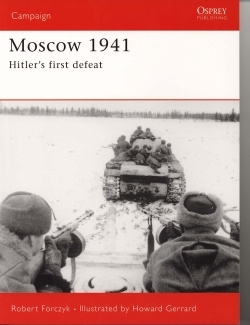 Here
is a very good account of what went wrong after the success of the initial
invasion of Russia. Mistakes were made on both sides, and Hitler’s
diversion of forces to Kiev may or may not be one of them but Stalin also
made mistakes. The German army was at its peak, but Russia’s reserves
of men coming from the eastern provinces and the sheer distances involved
weighed against German success. Although the Germans did get very close
to Moscow they had insufficient strength to drive any further and became
bogged down in the harsh Russian winter without proper preparation. Men
froze without adequate winter clothing, and tanks and trucks also froze
unless given constant attention. Here
is a very good account of what went wrong after the success of the initial
invasion of Russia. Mistakes were made on both sides, and Hitler’s
diversion of forces to Kiev may or may not be one of them but Stalin also
made mistakes. The German army was at its peak, but Russia’s reserves
of men coming from the eastern provinces and the sheer distances involved
weighed against German success. Although the Germans did get very close
to Moscow they had insufficient strength to drive any further and became
bogged down in the harsh Russian winter without proper preparation. Men
froze without adequate winter clothing, and tanks and trucks also froze
unless given constant attention.
All this may be familiar ground, but here the story is set out clearly
and very readably with some twists and turns that most non-specialists
are unaware of. There’s a good selection of photographs and the
plates are very good too. This book isn’t intended to give you details
of tank markings, but if you want to get your Panzer bases right for this
part of the Eastern Front fighting you will find it very useful.
Recommended.
Elite 138, The Yugoslav Wars (1) Slovenia & Croatia 1991-95, by
Dr N Thomas & K Mikulan, illustrated by D Pavlovic, ISBN 1-84176-963-0,
64 pages
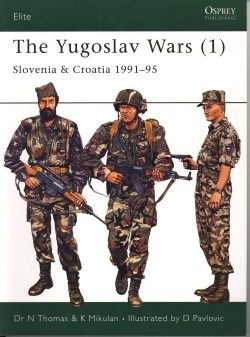 This
is a very clear account of the Slovene, Croatian and Krajina-Serb armies
during the breakup of former Yugoslavia. It begins with a look at the
historical background and continues with an analysis of the Yugoslav National
Army before the struggles began for independence from Serb control. Then
the Slovene army is described and a good account given of its successful
fight for independence. Next come the Croatian and Krajina-Serb armies
and the Serbian militias in Croatia, followed by a well-set-out description
of the fighting between them in the different regions of Croatia. All
this is accompanied by very good photographs of the various combatants
and by excellent colour plates, so although this is not a “uniform
book” it gives plenty of information for figure modellers as well
as being a good history of this unpleasant period. This
is a very clear account of the Slovene, Croatian and Krajina-Serb armies
during the breakup of former Yugoslavia. It begins with a look at the
historical background and continues with an analysis of the Yugoslav National
Army before the struggles began for independence from Serb control. Then
the Slovene army is described and a good account given of its successful
fight for independence. Next come the Croatian and Krajina-Serb armies
and the Serbian militias in Croatia, followed by a well-set-out description
of the fighting between them in the different regions of Croatia. All
this is accompanied by very good photographs of the various combatants
and by excellent colour plates, so although this is not a “uniform
book” it gives plenty of information for figure modellers as well
as being a good history of this unpleasant period.
Elite 139, Knight’s Cross with Diamonds Recipients 1941-45, by
Gordon Williamson, illustrated by Ramiro Bujeiro, ISBN 1-84176-644-5,
64 pages
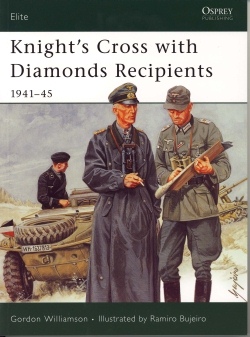 The
Knight’s Cross with Diamonds was only instituted at the end of September
1941, and this book give potted biographies of all its recipients. It
is noticeable when you read these that only Luftwaffe and Reichsmarine
officers seem to have received it for actual combat, the impression given
being that Heer and Waffen-SS Brilliantentraeger were senior commanders
honoured for directing combat. Nevertheless the men given this honour
were good at what they did and honoured accordingly. Here is everyone
from Moelders and Galland of the Luftwaffe to U-boat commanders and SS-Panzer
commander Sepp Dietrich. If you want to know about these men this is a
very good book to read, and Luftwaffe modellers will be glad to know that
the personal aircraft of three medal-winners are included in the good
colour plates. The
Knight’s Cross with Diamonds was only instituted at the end of September
1941, and this book give potted biographies of all its recipients. It
is noticeable when you read these that only Luftwaffe and Reichsmarine
officers seem to have received it for actual combat, the impression given
being that Heer and Waffen-SS Brilliantentraeger were senior commanders
honoured for directing combat. Nevertheless the men given this honour
were good at what they did and honoured accordingly. Here is everyone
from Moelders and Galland of the Luftwaffe to U-boat commanders and SS-Panzer
commander Sepp Dietrich. If you want to know about these men this is a
very good book to read, and Luftwaffe modellers will be glad to know that
the personal aircraft of three medal-winners are included in the good
colour plates.
Recommended.
Fortress 42, The Vauban Fortifications of France, by Paddy Griffin,
illustrated by Peter Dennis, ISBN 1-84176-875-8, 64 pages
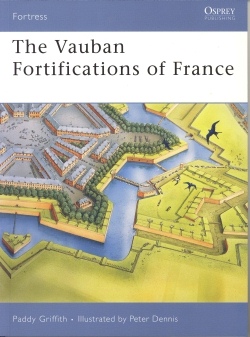 Most
readers interested in European history will have heard about Marshall
Vauban and his fortresses in France and on its frontiers. Here is a very
good explanation of them. Vauban was active for a good deal of the 17th
century, with anything up to 160 fortifications to his credit –
the picture is clouded, as explained here, by the number of his plans
executed by others. Sometimes they were build long after his death! Most
readers interested in European history will have heard about Marshall
Vauban and his fortresses in France and on its frontiers. Here is a very
good explanation of them. Vauban was active for a good deal of the 17th
century, with anything up to 160 fortifications to his credit –
the picture is clouded, as explained here, by the number of his plans
executed by others. Sometimes they were build long after his death!
The art of fortification involved a large number of technical terms
which confuse many of us – counterscarp, traverse, banquette, lunette
are just a few. Here is all anyone needs to know to understand them, set
out very clearly in the excellent plates showing various fortresses and
sections of them. If you visit any fortress of the period from 1650 to
1800 the information here will help you enormously in working out what
you are looking at and why it was built like that, whether in France,
the rest of Europe or, indeed, in North America.
Highly recommended!
Fortress 43, Roman Legionary Fortresses 27 BC – AD 378, by Duncan
B Campbell, illustrated by Brian Delf, ISBN 1-84176- 895-2, 64 pages
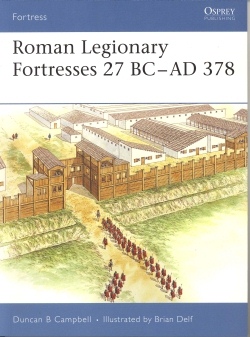 Apart
from its interest for visitors to Roman sites and lovers of Roman history
this is a good book for modellers of ancients – you do want accurate
settings for your Roman figures, don’t you? The first half describes
the evolution of the legionary forts through time, both in respect of
temporary marching camps and large permanent fortresses. The remainder
of the book deals with the standard layout and the types of building found
inside a fort – or outside in the case of some bathhouses. There
are plenty of plans of different forts, maps, photographs of what remains,
and excellent colour plates reconstructing the appearance of everything
from a wooden fortified gateway under siege to the insides of a legion’s
headquarters building and of a typical barrack block. Apart
from its interest for visitors to Roman sites and lovers of Roman history
this is a good book for modellers of ancients – you do want accurate
settings for your Roman figures, don’t you? The first half describes
the evolution of the legionary forts through time, both in respect of
temporary marching camps and large permanent fortresses. The remainder
of the book deals with the standard layout and the types of building found
inside a fort – or outside in the case of some bathhouses. There
are plenty of plans of different forts, maps, photographs of what remains,
and excellent colour plates reconstructing the appearance of everything
from a wooden fortified gateway under siege to the insides of a legion’s
headquarters building and of a typical barrack block.
This book is unmissable whether you want this book to put your figures
into a correct setting or as a guide to help understand what you see when
visiting a Roman site. Highly recommended.
Fortress 46, Castles and Tower Houses of the Scottish Clans 1450 -1650,
by Stuart Reid, illustrated by Graham Turner, ISBN 1-84176-962-2.64 pages
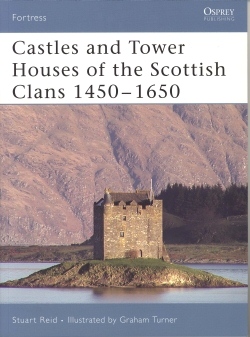 Anyone
interested in Scottish history will find this a great book, and as a guide
for visitors to Scotland it would be hard to beat in its field. Most Scottish
castles were not garrisoned fortresses like the Norman castles that we
all think of but family homes intended to protect their occupants against
raiders. Their development from basic types to late times is described
and illustrated here with plenty of plans, photographs, and old engravings.
Good colour plates of a selection of family tower-houses and larger castles
reconstruct their original appearance and show what they were like to
live in. A five-page section at the back tells you where the best surviving
examples can be seen, most of them open to the public though visitors
will need to check whether those still in family hands are open. Anyone
interested in Scottish history will find this a great book, and as a guide
for visitors to Scotland it would be hard to beat in its field. Most Scottish
castles were not garrisoned fortresses like the Norman castles that we
all think of but family homes intended to protect their occupants against
raiders. Their development from basic types to late times is described
and illustrated here with plenty of plans, photographs, and old engravings.
Good colour plates of a selection of family tower-houses and larger castles
reconstruct their original appearance and show what they were like to
live in. A five-page section at the back tells you where the best surviving
examples can be seen, most of them open to the public though visitors
will need to check whether those still in family hands are open.
Highly recommended.
Men-at-Arms 431, The Confederate Army 1861-65 (3) Louisiana & Texas,
by Ron Field, illustrated by Richard Hook, ISBN 1-84603-031-5, 48 pages
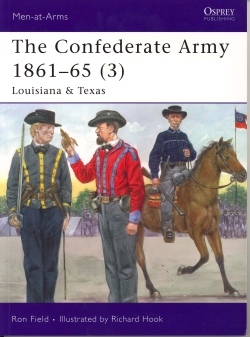 The
third part of this mini-series moves away from the eastern Regiments and
provides a look at the dress and equipment of the militias, volunteers
and regular units of Texas and Louisiana. The use of captured Union items
is covered, too. Like the earlier volumes it is plentifully illustrated
with old photographs which, backed up as they are by very good plates
and by descriptions in the text setting out all that is known about the
men’s appearance, will be great for figure modellers as well as
for anyone interested in the ACW period. The
third part of this mini-series moves away from the eastern Regiments and
provides a look at the dress and equipment of the militias, volunteers
and regular units of Texas and Louisiana. The use of captured Union items
is covered, too. Like the earlier volumes it is plentifully illustrated
with old photographs which, backed up as they are by very good plates
and by descriptions in the text setting out all that is known about the
men’s appearance, will be great for figure modellers as well as
for anyone interested in the ACW period.
Recommended.
New Vanguard 104, Cromwell Cruiser Tank 1942-50, by David Fletched &
Richard C Harley, illustrated by Peter Sarson, ISBN1-84176-814-6, 48 pages
 This
is a very welcome addition to the New Vanguard series. It deals with the
predecessors Cavalier and Centaur as well as with Cromwell, and the later
Comet, Avenger and Charioteer are covered as well. This makes it clear
that wartime pressure to build almost anything after the loss of tanks
in France, as well as bungling and bureaucracy, were the causes of the
lateness into service of a decent British cruiser tank. Excellent tables
give lots of information about builders, armament and user units, and
there are splendid tables of all the differences between the Marks and
hull types of Cavalier, Centaur and Cromwell, including the reworked Cromwells
and the Charioteers converted from Cromwells. These are worth the cost
of the book by themselves! This
is a very welcome addition to the New Vanguard series. It deals with the
predecessors Cavalier and Centaur as well as with Cromwell, and the later
Comet, Avenger and Charioteer are covered as well. This makes it clear
that wartime pressure to build almost anything after the loss of tanks
in France, as well as bungling and bureaucracy, were the causes of the
lateness into service of a decent British cruiser tank. Excellent tables
give lots of information about builders, armament and user units, and
there are splendid tables of all the differences between the Marks and
hull types of Cavalier, Centaur and Cromwell, including the reworked Cromwells
and the Charioteers converted from Cromwells. These are worth the cost
of the book by themselves!
There is no room in such a fact-packed book for combat stories, alas,
but every variant on these hulls is covered from the anti-aircraft and
Royal Marine Support Group Centaurs to recovery tanks and the mine-roller
and rocket-firing tests conducted with a Cromwell. Modellers will find
this book invaluable whether they’re building the Tamiya Cromwell
and Centaur kits, Accurate Armour’s Challenger and Charioteer, Cromwell
Models’ Cavalier, or the IMA Avenger.
The photographs are good, showing all the types, and the colour plates
also show a variety of tanks though oddly enough their captions do not
comment on camouflage colours, so although an RMASG Centaur CS in shown
you’re still on your own in deciding whether it was green or brown.
Very highly recommended.
New Vanguard 122, HMMWV Humvee 1980-2005, US Army tactical vehicle,
by Steven J Zaloga, illustrated by Hugh Johnson, ISBN 1-84176-946-0, 48
pages
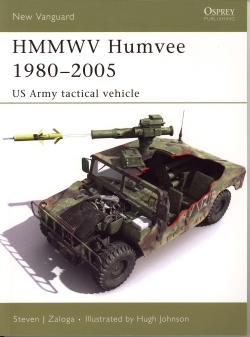 The
Humvee comes in a bewildering array of versions from the basic original
M998 to the latest –A2 upgrades, covering a multitude of tactical
uses with just as many M-numbers. Here Steve Zaloga describes its initial
development to replace an aging fleet of lighter vehicles that no longer
met requirements and then takes us through the whole family from unarmoured
load carriers to the latest armoured versions used in Iraq. The differing
armour fits - add-on, built in, and extemporised, are all described. He
also deals with the differences between US Army and US Marine versions
and describes some quite fascinating developments, including missile-armed
versions intended to replace the Hummer Avenger. The civilian Hummers
get a mention, with the upgrades taken from them for the military –A2
variants. Even laser-armed Hummers are included, and foreign users are
not neglected. This book will help a great deal in disentangling the various
Humvee types from each other in photographs, and there are plenty of good
colour photographs here to help as well as the colour plates. The
Humvee comes in a bewildering array of versions from the basic original
M998 to the latest –A2 upgrades, covering a multitude of tactical
uses with just as many M-numbers. Here Steve Zaloga describes its initial
development to replace an aging fleet of lighter vehicles that no longer
met requirements and then takes us through the whole family from unarmoured
load carriers to the latest armoured versions used in Iraq. The differing
armour fits - add-on, built in, and extemporised, are all described. He
also deals with the differences between US Army and US Marine versions
and describes some quite fascinating developments, including missile-armed
versions intended to replace the Hummer Avenger. The civilian Hummers
get a mention, with the upgrades taken from them for the military –A2
variants. Even laser-armed Hummers are included, and foreign users are
not neglected. This book will help a great deal in disentangling the various
Humvee types from each other in photographs, and there are plenty of good
colour photographs here to help as well as the colour plates.
Recommended!
New Vanguard 95, Armored Units of the Russian Civil War, Red Army, by
David Bullock, illustrated by Andrei Aksenov & Peter Sarson, ISBN
1-84176-545-7, 48 pages
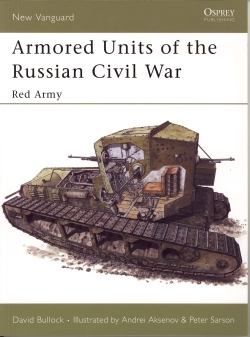 The
second volume of this set is well worth having in your collection. The
first 18 pages deal with armoured trains, describing their construction
and use with a lot of information about combat operations. Then come 10
pages giving similar detail about armoured cars – production and
import, organisation and combat use. Tanks take up the final 6 pages,
less space because there were fewer of them but just as much information
about the Renaults, MK V Heavies, Whippets that were captured and used.
A short section deals with colours and markings, and of course the colour
plates show some fascinating schemes for modellers. The photographs are
good and show interesting subjects, clearly there were some excellent
cameramen among the Red forces! The
second volume of this set is well worth having in your collection. The
first 18 pages deal with armoured trains, describing their construction
and use with a lot of information about combat operations. Then come 10
pages giving similar detail about armoured cars – production and
import, organisation and combat use. Tanks take up the final 6 pages,
less space because there were fewer of them but just as much information
about the Renaults, MK V Heavies, Whippets that were captured and used.
A short section deals with colours and markings, and of course the colour
plates show some fascinating schemes for modellers. The photographs are
good and show interesting subjects, clearly there were some excellent
cameramen among the Red forces!
Highly recommended to anyone with an interest in WWI tanks or in the
Red Army.
Osprey Modelling 28, Modelling the Tiger Tank in 1/72 scale, by Alex
Clark,
ISBN 1-84176-942-8, 80 pages
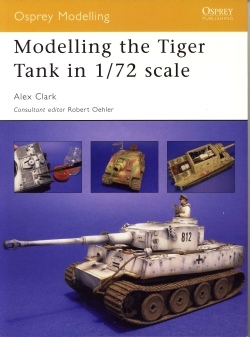 This
new book for small-scale tank modellers begins with a short introduction
and a section about tools and materials – from which I’m glad
to see that I’m not the only one who rarely picks up a power drill.
The first build is at Intermediate level, of the Revell Tiger II with
“Porsche” turret incorporating some parts from Dragon’s
kit of the same tank and using Atak add-on Zimmerit, the Part etched fender
set and an Aber turned metal gun barrel. Here there is very clear guidance
on the order of assembly, using the kit’s link and length tracks
and fitting the Atak zimmerit set as well as on dealing with etched brass
parts. Next is a second Intermediate build, this time combining the Dragon
Elefant kit with parts from the Trumpeter one and the Atak Zimmerit set
that includes the complete upper and lower hull. A Part etched set and
Aber turned metal barrel are also used, and some simple scratchbuilding
to replace the engine deck vents which are incorrect in both donor kits. This
new book for small-scale tank modellers begins with a short introduction
and a section about tools and materials – from which I’m glad
to see that I’m not the only one who rarely picks up a power drill.
The first build is at Intermediate level, of the Revell Tiger II with
“Porsche” turret incorporating some parts from Dragon’s
kit of the same tank and using Atak add-on Zimmerit, the Part etched fender
set and an Aber turned metal gun barrel. Here there is very clear guidance
on the order of assembly, using the kit’s link and length tracks
and fitting the Atak zimmerit set as well as on dealing with etched brass
parts. Next is a second Intermediate build, this time combining the Dragon
Elefant kit with parts from the Trumpeter one and the Atak Zimmerit set
that includes the complete upper and lower hull. A Part etched set and
Aber turned metal barrel are also used, and some simple scratchbuilding
to replace the engine deck vents which are incorrect in both donor kits.
The third model moves to Advanced level by building a correctly asymmetrical
turret to go on Revell’s early Tiger I. Again, Part etch and an
Aber barrel are used. Here there’s a very good guide to building
the new turret, not as difficult to do as you might think and clearly
described. This chapter also give hints on airbrushing a worn white camouflage
finish. Following it is another Advanced level model, Dragon’s Sturmtiger
built using parts from Revell’s Tiger I, Atak Zimmerit, Part photoetch
and an Extratech engine set. Here we are shown how to modify the hull
to display the engine and make extra improvements. The final model is
at Master level, Dragon’s Porsche-suspension Jagdtiger with parts
from Revell’s Henschell-suspension Tiger II, tracks from Dragon’s
Elefant, Part photoetch, an Aber turned metal barrel and the Extratech
Panther engine. There’s quite a lot of work in this one, not just
modifying the sprockets to fit the Elefant track and fitting the engine
but also scratchbuilding the driving and fighting compartment interiors
and the engine bay. All the work is shown and described briefly, but it
is assumed that anyone tackling a project at this level will already know
how to scratchbuild and will be capable of assessing dimensions and shapes.
A Gallery feature includes several other modellers’ work as well
as the author’s, and is followed by sections on references and available
kits.
All this is very well described and illustrated, and it’s a refreshing
change to find that the author has concentrated on how to build the models
rather than on how to achieve fancy paint effects. Highly recommended!
The Normans, Warrior Knights and their Castles, by Christopher Gravett
& David Nicolle, ISBN 1-84603-088-9, 256 pages
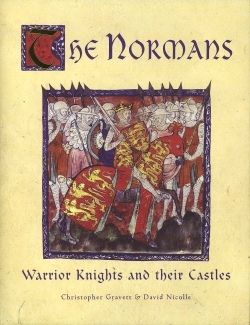 This
is a hardcover compiled from four previous Osprey books – David
Nicolle’s Elite 9, The Normans, and Christopher Gravett’s
Fortress 13, Norman Stone Castles (1) the British Isles, Fortress 18,
Norman Stone Castles (2) Europe, and Warrior 1, Norman Knight AD 950-1204.
That makes it an absolute bargain at the UK price of £20, and if
you are interested in the subject and don’t have the earlier books
it’s a bargain that shouldn’t be missed. There’s plenty
of information about the rise of Norman warriors in Britain and Europe,
their dress, armour and weapons, and of course about their castles. It
is very well presented and has excellent photographs and colour plates
of the knights and their castles so it’s good for figure modellers
and for the many of us who like to look at castles. There are maps to
show the castle locations too – making the book excellent as a tour
guide. Anyone who’s interested in castles will love it! This
is a hardcover compiled from four previous Osprey books – David
Nicolle’s Elite 9, The Normans, and Christopher Gravett’s
Fortress 13, Norman Stone Castles (1) the British Isles, Fortress 18,
Norman Stone Castles (2) Europe, and Warrior 1, Norman Knight AD 950-1204.
That makes it an absolute bargain at the UK price of £20, and if
you are interested in the subject and don’t have the earlier books
it’s a bargain that shouldn’t be missed. There’s plenty
of information about the rise of Norman warriors in Britain and Europe,
their dress, armour and weapons, and of course about their castles. It
is very well presented and has excellent photographs and colour plates
of the knights and their castles so it’s good for figure modellers
and for the many of us who like to look at castles. There are maps to
show the castle locations too – making the book excellent as a tour
guide. Anyone who’s interested in castles will love it!
Very highly recommended.
Osprey Modelling 27, Modelling the Focke-Wulf Fw 190 A, F and G, by
Geoff Coughlin, Osprey Publishing Ltd, ISBN 1-84176-935-5, 80 pages
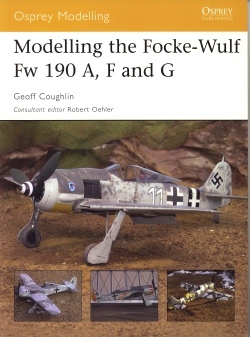 Here’s
a good set of ideas for modelling the short-nose 190s, with 6 models described
plus the usual chapter of special modelling ideas. After a short introduction
to the available kits and some comments on tools and materials it launches
straight into the first model, an Fw 190 A-8/R11 at 1/72 scale from the
Revell kit. This is at Intermediate level, so extra detailing is restricted
to the use of an Eduard etch set, Squadron cockpit canopy, True Details
wheels and Minimeca gun barrels. The work to use these is straightforward
and very clearly described, and the results look great. Here’s
a good set of ideas for modelling the short-nose 190s, with 6 models described
plus the usual chapter of special modelling ideas. After a short introduction
to the available kits and some comments on tools and materials it launches
straight into the first model, an Fw 190 A-8/R11 at 1/72 scale from the
Revell kit. This is at Intermediate level, so extra detailing is restricted
to the use of an Eduard etch set, Squadron cockpit canopy, True Details
wheels and Minimeca gun barrels. The work to use these is straightforward
and very clearly described, and the results look great.
Next is another Intermediate build, this time the Hasegawa 1/32 scale
Fw 190 A-5 built essentially straight from the box but with a lot of attention
given to the colour scheme and how to paint it. The third model is at
Advanced level, Tamiya’s 1/48 Fw 190 A4 with Cutting Edge wheels
and a True Details pilot’s seat plus Eagle Cal decals. This is another
straightforward build, with the Advanced part coming from its colour scheme
because of its sheer complexity! Then there’s another Advanced build,
this time the Hasegawa 1/32 Fw 190 F-8 but adding extra details from scratch
as well as using some aftermarket parts and demonstrating how to achieve
another complex colour scheme.
The final main build is at Master level, from the Hasegawa 1/32 kit
again but converting it to an A-8/R8 Rammjager with a Fabflight conversion
set for that version plus Eagle Parts’ cockpit, Eduard etch and
decals from Eagle Strike. This one takes a lot of work, and it’s
all very well described and shown on good photographs. The Special Ideas
chapter deals with making a wood-plank parking base of the kind found
on the Russian Front, and also gives some useful ideas on adding radio
aerial wires. To round off the book there are very good sections on recommended
further reading and websites, preserved 190s in museums around the world,
and a good analysis of the available kits.
Most of the work shown in this book will be easily done by most readers,
only the Master build being really complex in its construction aspect,
so even those who don’t count themselves as even Intermediate modellers
will be able to make good use of it to hone their techniques and try out
the painting ideas.
Recommended!
Warrior 103, Macedonian Warrior, Alexander’s elite infantrymen,
by Waldemar Heckel & Ryan Jones, illustrated by Christa Hook, ISBN
1-84176-950-9, 64 pages
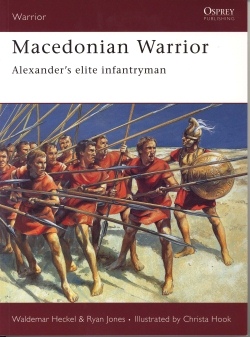 This
is a very scholarly book, written to give as much as in known without
speculation. It deals with the men of Alexander’s phalanx but actually
starts with a look at the historical background under Philip of Macedon
and the type of manpower that was available – hardy herdsmen from
the mountains. Recruitment and training are dealt with fairly briefly,
because of the lack of definite information, but weapons and armour are
described in detail, Pay, promotion and punishment are followed by a good
assessment of their condition on campaign and then there’s a very
interesting chapter on organisation. Next are descriptions of their major
battles, and then there’s a section on motivation. All these are
very well described and accompanied by excellent illustrations of preserved
finds from archaeological digs and of surviving wall paintings and sculptures.
The plates give good reconstructions of the men’s appearance and
their captions are very informative. This
is a very scholarly book, written to give as much as in known without
speculation. It deals with the men of Alexander’s phalanx but actually
starts with a look at the historical background under Philip of Macedon
and the type of manpower that was available – hardy herdsmen from
the mountains. Recruitment and training are dealt with fairly briefly,
because of the lack of definite information, but weapons and armour are
described in detail, Pay, promotion and punishment are followed by a good
assessment of their condition on campaign and then there’s a very
interesting chapter on organisation. Next are descriptions of their major
battles, and then there’s a section on motivation. All these are
very well described and accompanied by excellent illustrations of preserved
finds from archaeological digs and of surviving wall paintings and sculptures.
The plates give good reconstructions of the men’s appearance and
their captions are very informative.
Recommended. |
|